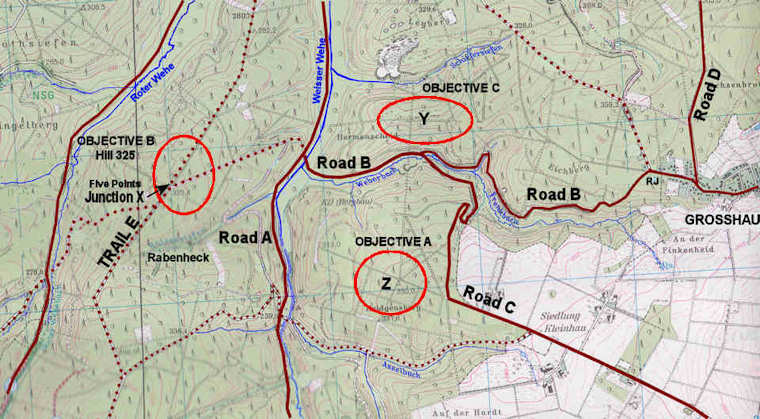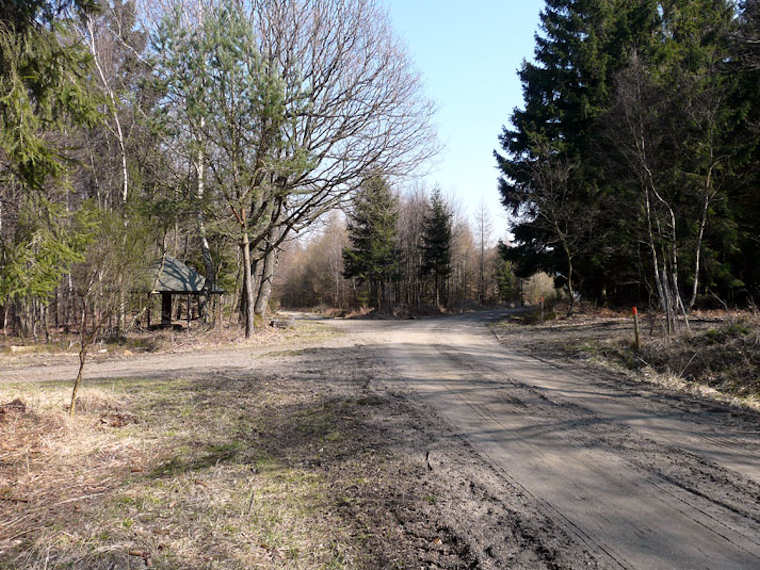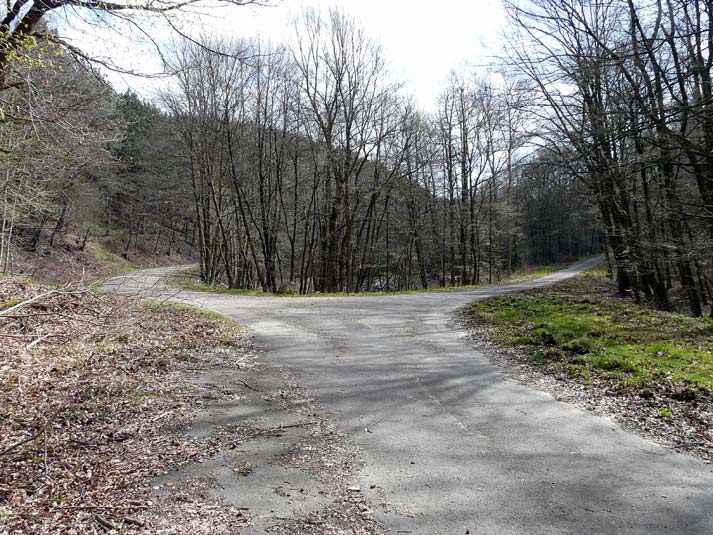(4TH INFANTRY DIVISION) IN THE HURTGEN FOREST,
GERMANY, 16 NOVEMBER - 3 DECEMBER 1944
(RHINELAND CAMPAIGN)
By Major Frederick T. Kent

THE ATTACK, 16 NOVEMBER - 3 DECEMBER
At 0100, 16 November, the regiment was notified that D-day was 16 November. A later message announced H-hour as 1245. 12
Preceding the jump-off, heavy artillery preparations were fired on both flanks of the area which the regiment planned to penetrate. At 1245 the 2nd Battalion crossed the line of departure and advanced about 600 yards before making contact with the enemy. Resistance increased and the advancing battalion was slowed down so that by 1610 the total gain was about 1500 yards and the battalion front had swung to the north so that it was generally perpendicular to the line of departure. 12 13
The 1st Battalion crossed the line of departure, turned north, and passed through one of the 2nd Battalion rifle companies to attack along Trail "E". This attack encountered the flank and rear of a well-organized enemy position and gradually slowed down. The battalion dug in for the night at 1640 after securing advantageous positions for the resumption of the attack the next day. 13

The 3rd Battalion dispatched one company at 1500 to clear the southern portion of Trail "E" and secure it for use as a temporary MSR. Another company soon followed and positions were taken which secured the trail and protected the south flank of the regiment. 13
Enemy mortar and artillery fire increased in intensity as the location of our effort became known to the Germans.
The attack for the 17th, to be made by 1st Battalion, was aimed at securing the high ground north of trail junction "X" and advancing eastward to seize the high ground which dominated Road "A". The attack was delayed from 0830 until 0945 by very heavy enemy mortar and artillery fire in which two battalion commanders were lost. The attack finally got under way at 0945 following a 30-minute artillery preparation. Fighter planes of the IX TAC supported the attack. Intense enemy fires of all types and extensive mine fields retarded the advance of the 1st Battalion. 13

Trail Junction X a.k.a. Five Points
The 2nd Battalion was ordered to push to the east to positions dominating Road "A". However, enemy infiltration to the rear of the battalion position and stiff resistance to the front combined to slow down the advance. 13
By 1630 both battalions had reached positions which dominated Road "A". The platoon of light tanks was used to support the 1st Battalion in this day's operations, but early in the day two tanks were knocked out by mines and the remaining two could not be employed because of dense woods and heavily-mined fire breaks. The enemy infiltration was cleared by using one company of the reserve battalion to clean out the area. 13
Noteworthy in this day's operations was the enemy's heavy and accurate fire on all trails and fire breaks which could be used as supply and evacuation routes. Engineer troops engaged in mine-sweeping and road maintenance were seriously hampered by this fire. This fire, as well as fire on the front-line units, continued during the night.
The plan for the following day called for the 1st and 2nd Battalions to attack abreast, cross Road "A", to seize hills "Y" and "Z". The 3rd Battalion, in reserve, was to protest the MSR. 13
The attack started at 0830 on the 18th as scheduled, and proceeded slowly against heavy fire. During the advance of the 2nd Battalion, Co "F", which had been protecting the south flank and had repulsed a small counterattack at daylight, started to move forward and lost direction and contact to such an extent that the company was not located again until late in the afternoon. Another unusual occurrence was the loss of the battalion commander, S-3, and communications officer. The Battalion Executive Officer and a new S-3 moved forward to assume command. Within 5 minutes after arriving at his command post, the new battalion commander was wounded and the new S-3 was dead. The Regimental S-2 then came forward to command the battalion. By the time he arrived at the battalion command post the entire staff had been evacuated. The S-2, assisted by one runner, regained control of the battalion and by 1650 had the battalion on its objective. 14
Since the regiment had both flanks and its rear open, with a frontage of more than 3500 yards of dense woods, only about 1500 yards of which were occupied, all-around defense was of vital importance and the units assumed night positions similar to the British hollow square. * 14
Ammunition and rations were pushed forward continuously to maintain a two-day supply within each battalion area at all times in case the unit was cut off from the remainder of the regiment. 14
The advances of the assaulting battalions and the heavy rains had now increased the road maintenance problem far beyond the capabilities of the one engineer platoon in support of the regiment. The fire breaks which were the main routes of communication became so soft and muddy that no vehicular traffic could negotiate them, and to get supporting armor to the front line units was out of the question. A considerable degree of assistance was received in this respect when two additional engineer platoons were placed in support of the regiment on 18 November. 15
At the close of the first three days of fighting, the regiment had advanced approximately 2000 yards at a cost of 300 enlisted and 24 officer casualties. 16
No attack was planned for 19 November as (1) Road "A" in CT 8's zone was still in enemy hands; (2) Trail "E" was still not clear of mines, and engineers were now removing the third layer from beneath the mud; (3) the hand carry of supplies and wounded had become so long that the use of all available personnel, including newly-arrived replacements, was still not enough to provide adequate supply and evacuation services; (4) the bridge across the swift-running stream at the junction of Roads "A" and "B" had been blown out and the site was under such heavy and continuous mortar and artillery fire including the fire of railroad guns, that it had been impossible to construct a new bridge, thus forcing all carrying parties and litter squads to ford the neck-deep icy water; and (5) the 3rd Battalion could not be counted on as an effective fighting force since Co "I", which had taken over the defensive flank on the north when the 1st Battalion had turned east from Trail "E", had not been relieved by the 24th Cavalry Reconnaissance Squadron, although this relief had been directed 34 hours earlier; and Co "L" had been seriously weakened by the loss of key personnel and the failure of mop-up parties to return. 16
The day was used to consolidate positions, reorganize, re-supply, and open Trail "E". Patrols were active on both sides and enemy mortar and artillery fire caused 109 casualties in the regiment. In the afternoon an enemy strongpoint to the east of the regimental command post opened fire on the security outpost. This enemy position had been by-passed by the 2nd Battalion and its existence indicated that it probably had been used to adjust the unusually accurate artillery fire which the 2nd Battalion had received on 18 November. Co "K" was moved to secure the command post and prepare to reduce this position. 17
The attack was resumed at 0850, 20 November. The 1st and 2nd Battalions were to advance along Road "B" to dominating ground about 600 yards to the east. The 3rd Battalion was to clear Road "A" to the regimental north boundary. The regimental zone of action was reduced in width by about 1000 yards by moving the boundary between the 22nd and 12th Infantry regiments to the north. 17
The enemy launched a coordinated attack against the 2nd Battalion positions at the same time that the 2nd Battalion attacked, and a hard, close-in fight resulted. The battalion advanced slowly and had one company on the objective by 1000. 18
The 1st Battalion met moderate resistance, reached its objective by 1017, mined Road "B" and repelled a small counterattacking force. An Infantry-armor counterattack was launched against the 2nd Battalion at 1050. Co "L" was sent to reinforce the battalion, the counterattack was repulsed, and Co "L" took up defensive positions covering the 2nd Battalion's right flank. 18
Co "K" attacked the strongpoint near the regimental command post at 1300, but did not reduce It by dark and was forced to wait until the following day to resume the attack. 18
Engineer troops started the construction of a bridge in the woods above the bridge site, as the enemy continued to interdict the road junction and bridge site. During the night 20-21 November the bridge was finally installed, Trail "E" was cleared, and armor was able to move to the forward battalions. 18
No attack was scheduled for 21 November, but several incidents occurred which aided the situation considerably. A small group of Germans who had been hidden within a few hundred yards of the bridge site surrendered to armored vehicles which had just crossed the new bridge. They undoubtedly had been directing the effective artillery fire which had kept the area untenable. Co "K" attacked the strongpoint near the command post, this time with one tank and a tank destroyer, and reduced the enemy position. Road "A" was cleared to the 8th Infantry positions. 18
In spite of the comparatively inactive day, the regiment suffered 306 casualties, mostly from mortar and artillery concentrations. This brought the total casualties for the operation up to 900 enlisted men and 42 officers. Replacements received through this day totaled 513 enlisted men and one officer. 18

Junction of Road B and C
The regiment resumed its advance on 22 November, with the 3rd Battalion passing to the left of the 1st Battalion and attacking to the southeast, with the 2nd Battalion attacking between roads "B" and "C" toward GROSSHAU. The 1st Battalion assisted by feinting several frontal attacks, distracting the enemy and allowing the 3rd Battalion to gain surprise effect. 19
By the end of the day, the 3rd Battalion dominated the road junction west of GROSSHAU. The 2nd Battalion had an exposed right flank which became more dangerous as the day passed, and one company of the 1st Battalion and 100 2nd Battalion replacements were sent to protect this flank. 19
On the 23rd, operations consisted of consolidation, clearing Road "B" to the road junction west of GROSSHAU, moving up armor and antitank guns, and mopping up. Limited objectives consisting of close-in trail junctions were secured or dominated by fire. A platoon of tanks moved to the 3rd Battalion and remained to support the battalion. 19
The 24th was another day of consolidation, reorganization, readjustment, mopping up, and resupply. Road "C" was cleared to the front lines. The 12th Infantry advanced in its zone and relieved some of the pressure on the 2nd Battalion's right flank, permitting Co "B" to return to 1st Battalion control. Co "A" moved east, tying in and extending the 3rd Battalion's left flank. Enemy fire continued to harass the regiment, and casualties now totaled 1,317 enlisted men and 52 officers. Replacements through this date now totaled 1,093 enlisted men and 32 officers, leaving the regiment still considerably under strength and painfully short in experienced specialists. 19
The attack on 25 November by the 2nd and 3rd Battalions was scheduled to be made with no artillery preparation in the hope of obtaining maximum surprise effect. The plan called for the 3rd Battalion to envelop GROSSHAU from the north, capturing the town from that direction. The 2nd Battalion's objective was the eastern edge of the woods at the regimental right boundary - a position from which direct fire could be placed on both GROSSHAU AND KLEIHHAU. The attack jumped off at 0745 and the 3rd Battalion had no trouble reaching a position about 800 yards north of GROSSHAU. At that time the battalion stopped while armored support was brought up to aid in the assault on the town. Due to the rough terrain and soft ground, this armor was delayed and the attack was not resumed until 1145. When the battalion started across the open ground, the enemy reacted vigorously. Self-propelled guns, mortars, and small arms fire from organized positions in the town stopped the attack, disabling four tanks and two tank destroyers. The battalion was unable to advance further due to the intensity of the enemy fire, and at 1500 dug in for the night. 19
The road to the 2nd Battalion was too soft to carry tanks, and the battalion was compelled to attack without armor in support. The battalion jumped off at 0820, and, in spite of intense enemy fire, drove to its objective by 1030. Tank support reached the battalion by late afternoon. 19
The 1st Battalion, in reserve, moved up close behind the 3rd Battalion. 19
No major attack was scheduled for 26 November as the regiment again needed reorganization. Positions were consolidated and improved. It became apparent that GROSSHAU, instead of being just another German village, was actually a fortified, heavily-defended strongpolnt, and that a major effort would be required to take the town. 19
During the day Co "C" attacked astride Road "B" to clear the area between the 2nd and 3rd Battalions and to free the road from enemy observation and direct fire. The two forward reduced the width of the regimental zone to 1200 yards, compared with the original 3500, and for the first time in the operation the regiment was able to cover its entire zone with no excessive gaps.
The only attack on 28 November was one on the north flank by a task force from the 3rd Battalion, in coordination with an attack by the 12th Infantry to seize the hill north of GROSSHAU. This mission was accomplished without much difficulty. 19
During the night 28 - 29 November a patrol reached Road "D" north of GROSSHAU and mined it, then withdrew back to its unit. 19
At the end of 28 November, total casualties had reached 1867 enlisted and 80 officers, and replacements totaled 1614 enlisted and 35 officers. 19
* British/hollow square: method of fighting off an attacking group by having the infantrymen form a square facing out on all sides with the officers in the center.

